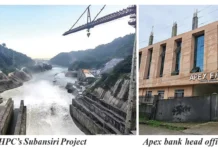GUWAHATI, 8 Apr: China’s announcement of constructing the world’s largest dam is like a “water bomb” which would have a devastating downstream impact on northeastern India and Bangladesh, BJP Lok Sabha member from Arunachal Pradesh Tapir Gao claimed here on Tuesday.
The lawmaker from Arunachal was addressing a conference on ‘Ensuring Water Security, Ecological Integrity and Disaster Resilience in the Sub-Himalayan Region: The Case of the Brahmaputra’.
“China has already decided to construct a dam which will have the capacity to produce 60,000 MW of electricity. This is not going to be a dam but a water bomb to be used against India and other lower riparian countries,” Gao said.
He claimed that the devastating floods of June 2000 were caused by a similar “water bomb” that had washed away more than 10 bridges on the Siang river, as the Yarlung Tsangpo is known in Arunachal before it becomes the Brahmaputra upon entering Assam.
”If China decides to release water from the dam in the future, Arunachal Pradesh, Assam, Bangladesh and other countries of South East Asia will be devastated,” he said.
The Arunachal East MP said that he supports the proposal of another dam to be built on the Siang river in his state, which would prevent disaster downstream due to the possibility of sudden release of water from the proposed dam.
There are legitimate concerns about this project as the dam could also disrupt water flow from Tibet, posing risks of flashfloods or reduced water availability downstream, he said.
”This would directly affect agriculture and water supply in India, particularly in Arunachal Pradesh and Assam, as well as in Bangladesh, increasing dependency on China for this critical resources,” the MP said.
The Government of India is diplomatically trying to talk to China on this issue so that the matter can be resolved, he said.
China approved on 25 December the construction of the world’s largest dam on the Yarlung Tsangpo in Tibet at an estimated cost of 137 billion US dollars.
The site of the largest dam is where the river makes a U-turn in China’s Medog county before entering Arunachal.
Brahmaputra Board Chairman Dr Ranbir Singh pointed out that the Brahmaputra basin is the only water-surplus river basin in India with the rest being water-deficient.
“With this dam in China, are we looking at a water-deficient Brahmaputra river basin or what other implications can be expected in the future – these are the questions that need to be addressed by a proper scientific study,” he said.
Singh also underlined the need for a multi-pronged strategy, including upping the ante against the project, garnering support in international circles, and through collaborations.
IIT Guwahati Professor Anamika Baruah pointed out that there is an information gap and lack of transparency on China’s side with the neighbouring country ”not sharing data.”
”We also do not have enough scientific data or tools to measure the actual impact that the world’s greatest dam will have on the downstream countries,” she said.
Experts from Vietnam, Nepal and Bhutan also took part in the conference, along with other experts spanning domains of ecology, water resource management, international relations, environmental law, engineering, policy formulation, governance, and economy.
The conference, organised by the think-tank Asian Confluence, sought to foster a collaborative dialogue between governmental agencies, civil society organisations, environmental practitioners, and academicians on the immense challenges posed by the proposed dam in Tibet, amidst the looming threat of climate change.
Asian Confluence director Sabyasachi Dutta said that the need of the hour is to have more scientific studies initiated by India which will help develop solid ground for international support against China’s proposed dam at the Big Bend. (PTI)




